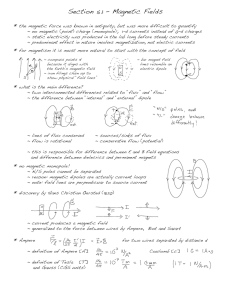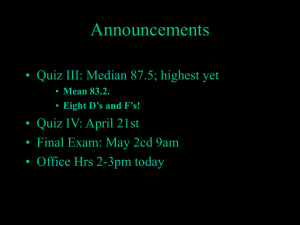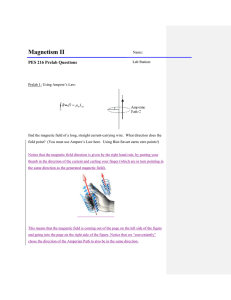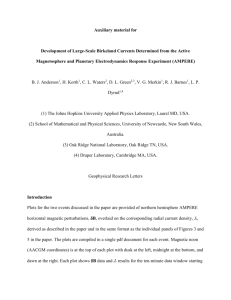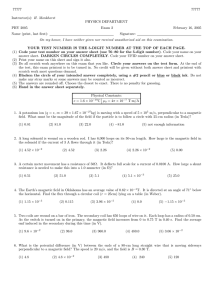Experiment #9 Ampere’s Law Prelab Hints
advertisement
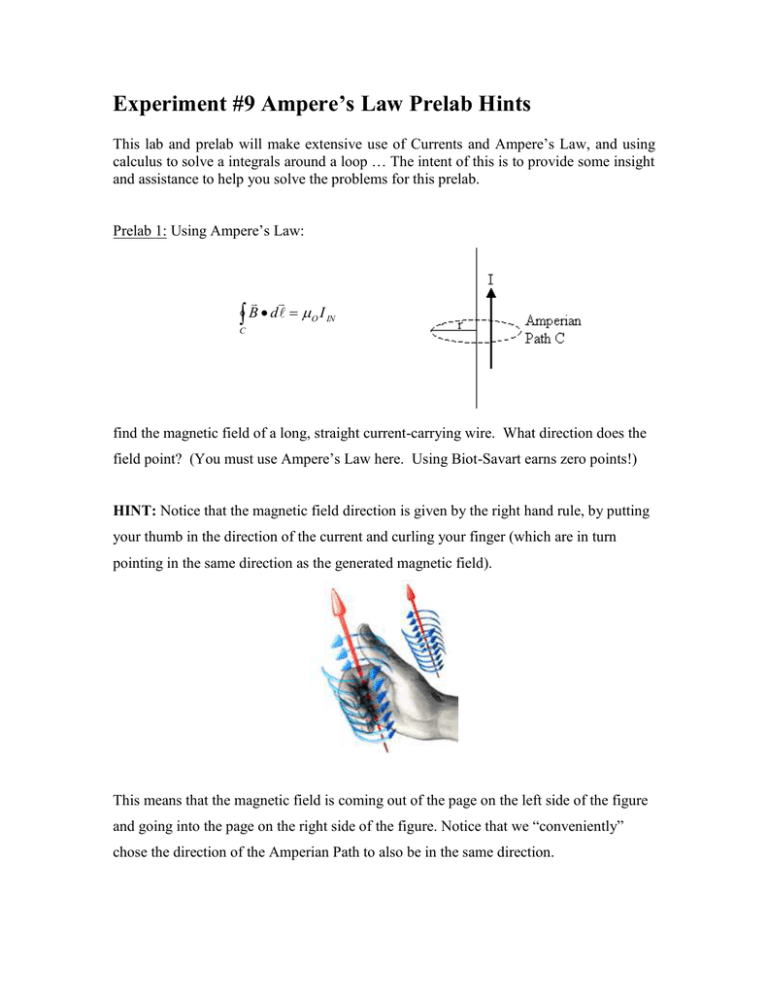
Experiment #9 Ampere’s Law Prelab Hints This lab and prelab will make extensive use of Currents and Ampere’s Law, and using calculus to solve a integrals around a loop … The intent of this is to provide some insight and assistance to help you solve the problems for this prelab. Prelab 1: Using Ampere’s Law: B d O I IN C find the magnetic field of a long, straight current-carrying wire. What direction does the field point? (You must use Ampere’s Law here. Using Biot-Savart earns zero points!) HINT: Notice that the magnetic field direction is given by the right hand rule, by putting your thumb in the direction of the current and curling your finger (which are in turn pointing in the same direction as the generated magnetic field). This means that the magnetic field is coming out of the page on the left side of the figure and going into the page on the right side of the figure. Notice that we “conveniently” chose the direction of the Amperian Path to also be in the same direction. I cheated and used Biot-Savart law first and saw that the answer I should come up with I should be: B o ˆ 2r If we draw in the Amperian Path (in blue), the wire and current (in black) and a coordinate axis frame, we can start to describe the magnetic field (in red) being generated. If we take a “top down” view of this, it is very easy to see that the magnetic field sits in the X-Z plane and moves in the counter-clockwise direction (this is given the direction ˆ ). Using Ampere’s Law: B d I O IN C First, let’s consider the Right Hand Side (RHS) of Ampere’s Law: O I IN O I In this case, I-inclosed is just the total current flowing through the wire (I). Next, let’s consider the Left Hand Side (LHS) of Ampere’s Law: B d C Notice that the Amperian Loop we selected, the distance segment (which is an infinitesimal length tangent to the Amperian loop) is always pointing in the same direction as the magnetic field. This means that the angle between the distance segment and the magnetic field will always be zero. Solve the integral using the bounds of 0 Circumfrence of the Amperian loop (of radius r), and use the definition of the dot product as the product of the magnitudes times the angle between the vectors (see prelab 4 if you need a refresher). <SHOW YOUR WORK HERE> Next, set the LHS (integral evaluated at the bounds) equal to the RHS: <SHOW YOUR WORK HERE> Finally, putting everything together and solving for the Magnetic Field: <SHOW YOUR WORK HERE> <NOTE: You should have BOTH a magnitude AND a direction. The direction is in the theta hat direction> Prelab 2: Using Ampere’s Law, find the magnetic field inside a solenoid. What direction does the field point? HINT: Actually, I find the image above a little ambiguous. It’s hard for me to tell which way the current is actually going (with respect to what is out of the page and what is into the page). For my response to this question, I’m going to modify the image slightly to help explain this a little better (since the magnetic field direction will be determined by the current’s direction). This makes it easier to see that the current is coming out of the page on the left side (solid line) and then back into the page (dashed line). Likewise, we give a 3D orientation to use for directions, and finally – we specify the direction the path is going to follow around the Amperian Path. With these modifications, then by using the right hand rule we can determine the direction the magnetic field will point: Similar to above, if we draw in the Amperian Path (in blue), the wire and current (in black) and a coordinate axis frame, we can start to describe the magnetic field (in red) being generated. Hence, the magnetic field is pointing to the right ( x̂ direction). Again, I did the math and for this solenoid I came up with a magnetic field of: NI B o xˆ Using Ampere’s Law: B d O I IN C First, let’s consider the Right Hand Side (RHS) of Ampere’s Law: O I IN O N I (Where N is the number of loops contained within the amperian path, C). Next, let’s consider the Left Hand Side (LHS) of Ampere’s Law: B d C We need to consider the angle between the magnetic field and the line element (of each of the four sides of the Amperian path that we selected) so we can evaluate the dot product for each line element. For the Amperian Loop we have defined, we know the LHS is thus: B d B d B d B d B 1 2 3 d4 C C C C C Since there are multiple dot products to evaluate here, we will need to remember the value of the cosine function at various angles: Angle 0o Cosine (Angle) +1 90 o 180 o 270 o 360 o 0 -1 0 +1 We need to consider each of the 4 integrals separately: B d 1 ?? ( Note the field is B 0 outside the solenoid ) C B d 2 ?? ( Note the angle between the vectors dl 2 and B 270 o ) C o B d 3 ?? ( Note the angle between the vectors dl2 and B 90 ) C o B d 4 ?? ( Note the angle is 0 AND the bounds go from 0 for the length ) C Now solve the four integrals and add them up: <SHOW YOUR WORK HERE> Next, set the LHS (integral evaluated at the bounds) equal to the RHS: <SHOW YOUR WORK HERE> Finally, putting everything together and solving for the Magnetic Field: <SHOW YOUR WORK HERE> <NOTE: You should have BOTH a magnitude AND a direction. The direction is in the +x hat direction> Finall, If we let “n” be the number of loops per unit length, what does the magnetic field simplify to?? <SHOW YOUR WORK HERE> Prelab 3: This lab uses high currents of a few amps. You need to worry about safety in this lab. High electric currents cause the circuit to heat up dramatically, and they also pose an electric shock hazard. What precautions do you need to take when doing this lab? (Hint: Read The Lab section of the manual.) <This should be obvious>
